By Dr. Ileana Johnson Paugh ——Bio and Archives--September 24, 2011
Cover Story | CFP Comments | Reader Friendly | Subscribe | Email Us
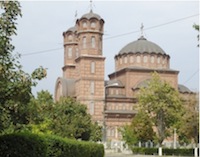 Transitioning from a communist/socialist controlled economy to a mixture of capitalism and European socialism was not painless for the former communist country of Romania. After the bloody revolution of December 1989, the country embarked on a series of difficult economic changes and adaptations that culminated in its admission into the European Union on January 1, 2007.
Jumping from the communist party’s inadequate and random five-year economic plans that bore no resemblance to the needs and wants of society to a market system based on supply and demand was quite difficult. Between 1948 and 1989, Romania had a state-controlled economy built around heavy industry.
Transitioning from a communist/socialist controlled economy to a mixture of capitalism and European socialism was not painless for the former communist country of Romania. After the bloody revolution of December 1989, the country embarked on a series of difficult economic changes and adaptations that culminated in its admission into the European Union on January 1, 2007.
Jumping from the communist party’s inadequate and random five-year economic plans that bore no resemblance to the needs and wants of society to a market system based on supply and demand was quite difficult. Between 1948 and 1989, Romania had a state-controlled economy built around heavy industry.  Free to worship, citizens are now rebuilding churches, 6,000 and counting. This beautiful cathedral was built in my old neighborhood in Ploiesti.
Millions of dollars were borrowed after Ceausescu’s demise by unscrupulous individuals from the former communist regime who never paid back their loans, had no intentions to pay them back, causing the collapse of many banks in the process, and necessitating bailouts similar to our TARP. Those who were honest then and refused the loans, are still poor today.
Former regime leaders, politicians, and their families bought companies and other personal investments with the borrowed money. Some also sold piece by piece, for personal gain, various state-owned factories to foreign investors without any scrutiny or challenge from the complicit legal system. The corruption was endemic and the population at large could do nothing about it.
Romania’s economic growth was among the fastest in Europe at 8.4% in 2008 and three times the EU average. Romania is expected to join the Euro zone by 2014.
The global financial downturn affected Romania heavily when GDP contracted 7.2% in 2009, forcing the government to enact austerity measures and to borrow heavily from the International Monetary Fund, while carrying a budget deficit of 6.6 percent.
People’s lives in general have improved. Many main roads have been enlarged and country roads paved. Most villages were electrified. Small private companies sprouted like mushrooms in both urban and rural areas. All villages now have grocery stores, phone service, satellite dishes, a new schoolhouse, and a new or remodeled church. Bikes are everywhere, encouraged by grants from UN Agenda 21 European groups.
Free to worship, citizens are now rebuilding churches, 6,000 and counting. This beautiful cathedral was built in my old neighborhood in Ploiesti.
Millions of dollars were borrowed after Ceausescu’s demise by unscrupulous individuals from the former communist regime who never paid back their loans, had no intentions to pay them back, causing the collapse of many banks in the process, and necessitating bailouts similar to our TARP. Those who were honest then and refused the loans, are still poor today.
Former regime leaders, politicians, and their families bought companies and other personal investments with the borrowed money. Some also sold piece by piece, for personal gain, various state-owned factories to foreign investors without any scrutiny or challenge from the complicit legal system. The corruption was endemic and the population at large could do nothing about it.
Romania’s economic growth was among the fastest in Europe at 8.4% in 2008 and three times the EU average. Romania is expected to join the Euro zone by 2014.
The global financial downturn affected Romania heavily when GDP contracted 7.2% in 2009, forcing the government to enact austerity measures and to borrow heavily from the International Monetary Fund, while carrying a budget deficit of 6.6 percent.
People’s lives in general have improved. Many main roads have been enlarged and country roads paved. Most villages were electrified. Small private companies sprouted like mushrooms in both urban and rural areas. All villages now have grocery stores, phone service, satellite dishes, a new schoolhouse, and a new or remodeled church. Bikes are everywhere, encouraged by grants from UN Agenda 21 European groups.
 Grocery store in a village with customers’ bikes
Grocery store in a village with customers’ bikes
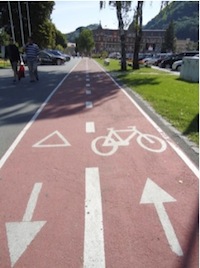 Fancy bike path in downtown Brasov
There is an explosion of automobiles, even in the country, but fuel is very expensive, $10 or more per gallon. Evidence of UN Agenda 21 measures is everywhere: new high-rise tenements with shops on the first floor, smart meters, lack of parking but an abundance of bikes, walking, and public transportation, anemic use of electricity which is very expensive, A/C units that are seldom used because electricity is cut off for several hours a day if consumption peaks.
Fancy bike path in downtown Brasov
There is an explosion of automobiles, even in the country, but fuel is very expensive, $10 or more per gallon. Evidence of UN Agenda 21 measures is everywhere: new high-rise tenements with shops on the first floor, smart meters, lack of parking but an abundance of bikes, walking, and public transportation, anemic use of electricity which is very expensive, A/C units that are seldom used because electricity is cut off for several hours a day if consumption peaks.
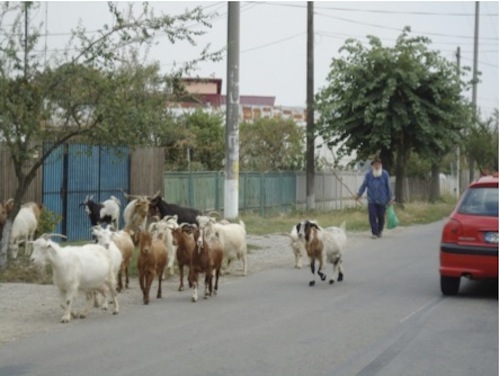 Cars and goats sharing the road in a village
Gas stations have been placed in the most unexpected locations like the middle of a cornfield or a cemetery. There was one station built on the sidewalk that I used when I went to high school, crowded against the cemetery wall.
Parking spaces are so few, people park on sidewalks or block the lanes closer to the curb. No cops in sight were giving tickets.
People are free to travel, free to move from town to town, but are still bound by the communist era union labor I.D., a passport sized book that holds the official employment history and stamped record of every citizen.
Having joined the European Union in 2007, the socialist nanny state was reintroduced through a novel idea, welfare. There were no more lines for food or basic goods as we experienced under communism, but I photographed a line and curiously asked what they were selling there. A strapping young man answered, perhaps embarrassed or puzzled by such a question, that they were standing in line for social welfare. All of a sudden, when easy money was being offered, an unusual number of people had become needy and extremely poor.
Cars and goats sharing the road in a village
Gas stations have been placed in the most unexpected locations like the middle of a cornfield or a cemetery. There was one station built on the sidewalk that I used when I went to high school, crowded against the cemetery wall.
Parking spaces are so few, people park on sidewalks or block the lanes closer to the curb. No cops in sight were giving tickets.
People are free to travel, free to move from town to town, but are still bound by the communist era union labor I.D., a passport sized book that holds the official employment history and stamped record of every citizen.
Having joined the European Union in 2007, the socialist nanny state was reintroduced through a novel idea, welfare. There were no more lines for food or basic goods as we experienced under communism, but I photographed a line and curiously asked what they were selling there. A strapping young man answered, perhaps embarrassed or puzzled by such a question, that they were standing in line for social welfare. All of a sudden, when easy money was being offered, an unusual number of people had become needy and extremely poor.
 Social welfare line
Older people who did not like the competition of a free market, became nostalgic for the old communist regime, some putting flowers on Ceausescu’s tomb, although nobody knew for sure whether he was buried there. They preferred the certainty of poverty under communism to the uncertainty of capitalist competition. The PSD, the Social Democrat Party, in collusion with European Socialist Party seized on this opportunity to buy their votes through occasional gifts of food and money.
Brigitte Bardot, an aging French actress, came into Romania and introduced PETA. The citizens understood that they were to leave dogs and cats alone to roam the streets and free to reproduce to the point that they have become a problem for every village and town. They are everywhere, neglected, some fed, some hungry, diseased, and pitiful. They’ve even created a word for them, “maidanezi.”
Social welfare line
Older people who did not like the competition of a free market, became nostalgic for the old communist regime, some putting flowers on Ceausescu’s tomb, although nobody knew for sure whether he was buried there. They preferred the certainty of poverty under communism to the uncertainty of capitalist competition. The PSD, the Social Democrat Party, in collusion with European Socialist Party seized on this opportunity to buy their votes through occasional gifts of food and money.
Brigitte Bardot, an aging French actress, came into Romania and introduced PETA. The citizens understood that they were to leave dogs and cats alone to roam the streets and free to reproduce to the point that they have become a problem for every village and town. They are everywhere, neglected, some fed, some hungry, diseased, and pitiful. They’ve even created a word for them, “maidanezi.”
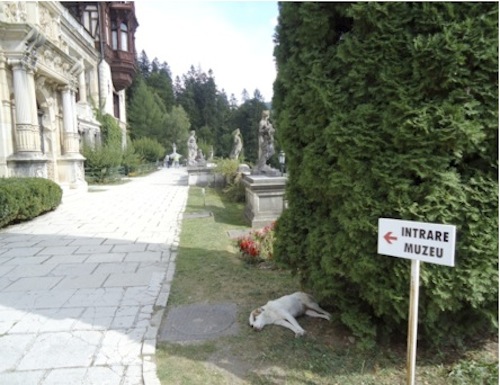 This stray dog made his home around the museum entrance in Sinaia.
There are supermarkets everywhere, people have plenty of food, seem happier, look healthier, and smile more. Food is being imported because some fields are no longer worked, they had been abandoned when the communist co-operatives were closed and the land sold to investors.
Some fields are idle because it is too expensive or too hard to put in crops. Young men and women who were providing the labor have gone to other countries to make decent wages in Spain, Italy, France, and Germany. They come back a few times a year to see their families, build new homes, bring a new car, appliances, and money.
Private medical clinics and hospitals were built but few Romanians can afford to use them. Socialized state run medical care is the same communist style care with newer testing equipment such as CT scans and MRIs. People have to wait months and years for their turn to use the new equipment and tests that we take for granted and we can schedule in a few days, not months.
Drugs are now available but even the socialized medical system only gives free drugs to fewer citizens, the rest have to pay 50 percent of the cost. Pharmacy shelves are no longer empty as they were under communism.
This stray dog made his home around the museum entrance in Sinaia.
There are supermarkets everywhere, people have plenty of food, seem happier, look healthier, and smile more. Food is being imported because some fields are no longer worked, they had been abandoned when the communist co-operatives were closed and the land sold to investors.
Some fields are idle because it is too expensive or too hard to put in crops. Young men and women who were providing the labor have gone to other countries to make decent wages in Spain, Italy, France, and Germany. They come back a few times a year to see their families, build new homes, bring a new car, appliances, and money.
Private medical clinics and hospitals were built but few Romanians can afford to use them. Socialized state run medical care is the same communist style care with newer testing equipment such as CT scans and MRIs. People have to wait months and years for their turn to use the new equipment and tests that we take for granted and we can schedule in a few days, not months.
Drugs are now available but even the socialized medical system only gives free drugs to fewer citizens, the rest have to pay 50 percent of the cost. Pharmacy shelves are no longer empty as they were under communism.
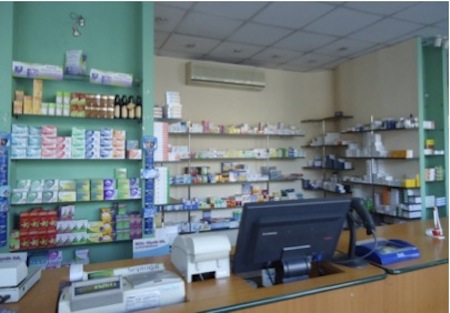 A modern pharmacy in Ploiesti
Hospitals operate the same way they used to under communism, patients have to be cared for pre- and post-operative by a family member; sheets, food, and all necessities, including drugs must be purchased by the patient.
Doctors do not have a say in their salaries and must go to the town or village they are assigned after graduation and practice medicine. There is a chronic shortage of nurses and doctors because nobody wants to study 6-8 years in college in order to make the same salary as a high school graduate. Bribes are still given, expected, and accepted for better service.
Education has gone down in quality. Students are discouraged from studying history and no longer take pride in who they are and where they have come from. It is a deliberate attempt to indoctrinate the new generation into the European mindset of a one-world government without borders, national identity, and sovereignty.
Communist era uniforms are gone except for kindergarten and elementary school. Other students wear western clothes to class. Girls parade in more revealing attire than necessary while boys dress age appropriate. The young are being targeted through clever advertising campaigns by local socialists with copious help and funds from the European Socialist Party, which has infiltrated the cities.
Historical buildings are abandoned and uncared for, rusting and decaying in the wind, rain, and snow. Graffiti covers the walls of these monuments, of historical and public buildings, and nobody seems to care.
A modern pharmacy in Ploiesti
Hospitals operate the same way they used to under communism, patients have to be cared for pre- and post-operative by a family member; sheets, food, and all necessities, including drugs must be purchased by the patient.
Doctors do not have a say in their salaries and must go to the town or village they are assigned after graduation and practice medicine. There is a chronic shortage of nurses and doctors because nobody wants to study 6-8 years in college in order to make the same salary as a high school graduate. Bribes are still given, expected, and accepted for better service.
Education has gone down in quality. Students are discouraged from studying history and no longer take pride in who they are and where they have come from. It is a deliberate attempt to indoctrinate the new generation into the European mindset of a one-world government without borders, national identity, and sovereignty.
Communist era uniforms are gone except for kindergarten and elementary school. Other students wear western clothes to class. Girls parade in more revealing attire than necessary while boys dress age appropriate. The young are being targeted through clever advertising campaigns by local socialists with copious help and funds from the European Socialist Party, which has infiltrated the cities.
Historical buildings are abandoned and uncared for, rusting and decaying in the wind, rain, and snow. Graffiti covers the walls of these monuments, of historical and public buildings, and nobody seems to care.
 Abandoned historical building covered in weeds
Cheating on exams is endemic, many students pass major exams by buying the tests from their professors. Scandals are covered in the press.
Food is plentiful but expensive. Prices mirror European Union levels but salaries and pensions have not caught up to the same level as the EU, on the contrary, they were cut to meet the president’s established austerity measures as dictated by the EU.
Housing prices are over inflated when compared with similar housing in Europe. Expensive boutiques cater to the very rich while ordinary citizens buy cheap imports from China.
Villagers who chose to keep their parcel of land grow their own vegetables, corn, wheat, barley; some raise a pig, a cow for milk and cheese, a few goats, sheep, chicken, rabbits, and ducks. In a food shortage situation, farmers will fare much better than urban dwellers.
Time will tell if Romania will continue its development on the path of free market capitalism or will be forced to adopt the European socialist nanny state model entirely, in essence returning to its painful communist past.
Abandoned historical building covered in weeds
Cheating on exams is endemic, many students pass major exams by buying the tests from their professors. Scandals are covered in the press.
Food is plentiful but expensive. Prices mirror European Union levels but salaries and pensions have not caught up to the same level as the EU, on the contrary, they were cut to meet the president’s established austerity measures as dictated by the EU.
Housing prices are over inflated when compared with similar housing in Europe. Expensive boutiques cater to the very rich while ordinary citizens buy cheap imports from China.
Villagers who chose to keep their parcel of land grow their own vegetables, corn, wheat, barley; some raise a pig, a cow for milk and cheese, a few goats, sheep, chicken, rabbits, and ducks. In a food shortage situation, farmers will fare much better than urban dwellers.
Time will tell if Romania will continue its development on the path of free market capitalism or will be forced to adopt the European socialist nanny state model entirely, in essence returning to its painful communist past.View Comments
Dr. Ileana Johnson Paugh, Ileana Writes is a freelance writer, author, radio commentator, and speaker. Her books, “Echoes of Communism”, “Liberty on Life Support” and “U.N. Agenda 21: Environmental Piracy,” “Communism 2.0: 25 Years Later” are available at Amazon in paperback and Kindle.